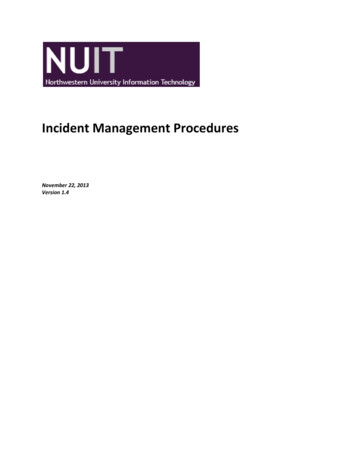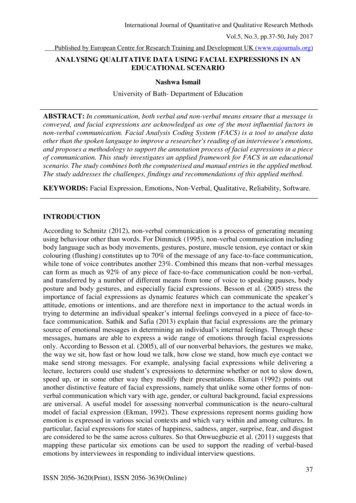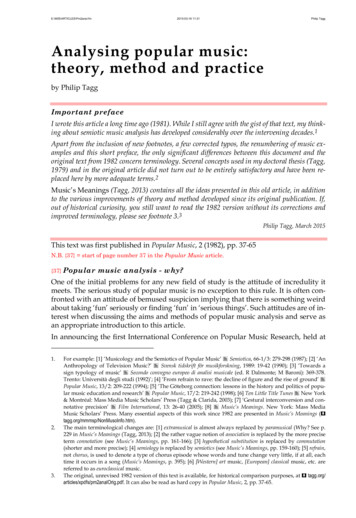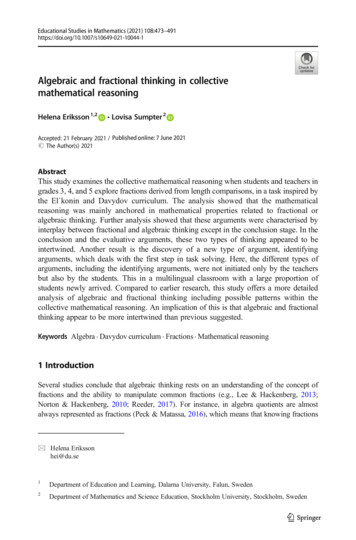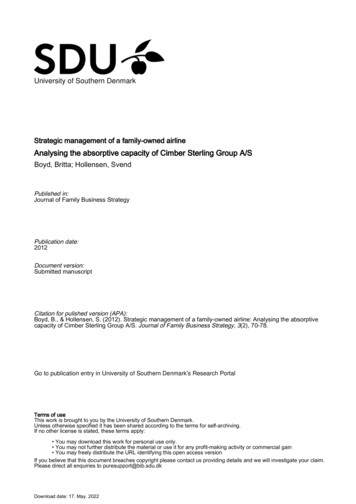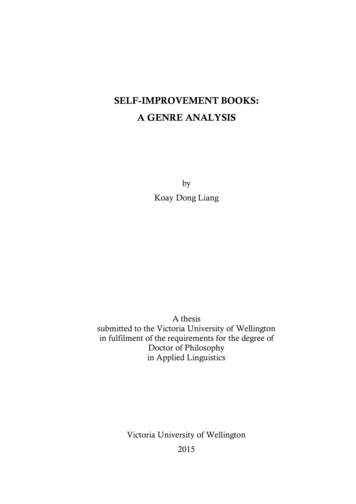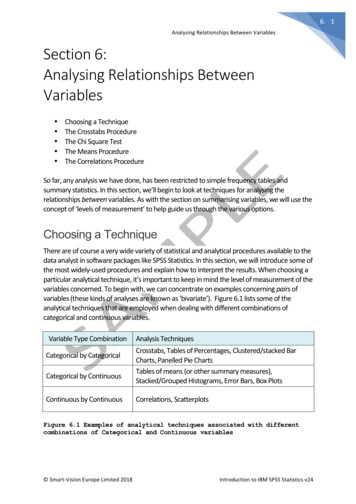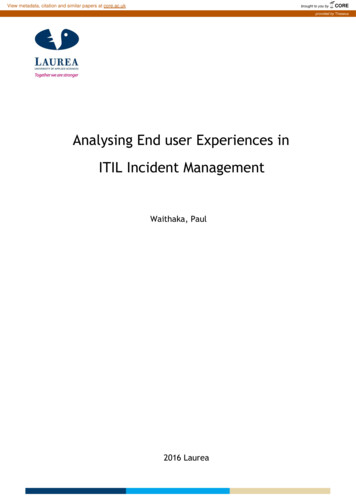
Transcription
View metadata, citation and similar papers at core.ac.ukbrought to you byCOREprovided by TheseusAnalysing End user Experiences inITIL Incident ManagementWaithaka, Paul2016 Laurea
Laurea University of Applied SciencesAnalysing End user Experiences in ITIL Incident Management.Case company
Waithaka, PaulDegree Programme inBusiness Information TechnologyBachelor’s ThesisDecember, 2016
Laurea University of Applied SciencesDegree Programme in Business Information TechnologyBachelor’s ThesisAbstractWaithaka, PaulAnalysing End user Experiences in ITIL Incidence Management.Year2016Pages38This thesis focuses on end user experiences in the handling of the incident management process in the case company, based on the incident process outlined in the Information Technology Infrastructure Library (ITIL). Incident management has been implemented in the companyusing an IT service suite, BMC Remedy, and following the ITIL service management framework, but some problems needed to be addressed due to the long processing time experienced which affect service delivery to the users. The main objectives were to find out whyincident processing took so long and to determine the areas to be addressed at a later stagein order to have better service.The theoretical part for the process includes a review of the implemented procedures in thecompany’s incident management manual and the knowledge of the best IT service management practices outlined in the ITIL framework. The data was collected through a survey conducted in the company and analysed using the feedback and suggestions given by the users onthe status of various factors that affect the time taken to get solutions for incidents.The outcome of this thesis is based on the user feedback on three key areas that affect timetaken on incidents identification, reporting and resolution namely the incident reporting quality, incident request orientation and incident request communication. The issues addressedwould aim at reducing the duration of ticket resolution, and solve the challenges experiencedby the users when reporting and receiving information on incidents resolution.
Keywords: Incident Management, ITIL, Service management
Table of Contents12Introduction . 81.1Case Company Background . 81.2Organizational Challenge . 81.3Research Question and structure . 9Theoretical Background and Knowledge Base . 92.1ITIL Framework . 102.1.1 ITIL and good practice in service management. . 102.1.2 Incident Management . 122.1.3 Purpose of Incident Management . 122.1.4 Incident Management Procedure . 132.2BMC Remedy Management Platform . 142.3Incident Management Lifecycle. 152.3.1 Incident Creation . 152.3.2 Incident Management Roles . 172.3.3 Incident Prioritization . 172.434Incident Impact Metrics . 19Research Process . 223.1Data collection and handling. . 223.2Research Methods . 22Description of survey . 234.1The survey . 234.2Analysis and Results . 244.2.1 Incident Request Quality . 244.2.2 Incident Request Orientation . 254.2.3 Incident Request Communication . 2656User Feedback and Opinions . 275.1Incident request feedback . 285.2Incident Orientation feedback. . 285.3Incident Communication feedback. . 28Discussions and Conclusion . 296.1Summary of the study . 29References . 31Figures . 32Tables . 33Appendix 1Survey Questions . 34Appendix 2Incident request feedback . 35Appendix 3incident orientation feedback . 36
Appendix 4incident communication feedback . 37Appendix 5Survey results . 38
1IntroductionBackground and purpose of the studyThis thesis focuses on analysis of the business user’s experiences during the process of reporting and receiving support on mainly ICT incidents while working. An IT service managementsuite - BMC Remedy software for reporting and resolving all types of issues and incidences experienced by the users working with various types of IT tools (Hardware or software) in thecase company. For the purposes of this study an IT framework was used. The IT service management Framework ITIL (IT Infrastructure Library) for the processes in service managementand specifically incident management. The BMC Remedy Platform service provides the organization with a platform to report various incidents and problems experienced by business users. The tool is aligned to support ITIL with its aligned incident management modules whichallow the case company to streamline the use of different service tools available to the customer for incident and problem reporting and resolution and in turn make a more efficientincident management process.1.1Case Company BackgroundThe case company for this study is an organization based in Helsinki Finland set up to manageand regulate all the chemical industries in Europe that use or manufacture different types ofproducts that use chemicals or its by product. The organization helps companies to comply withthe legislation, advances the safe use of chemicals, provides information on chemical and addresses chemicals of concern. This regulation is done for the benefit of human health and theenvironment, and also provide information to the public on these substances. To achieve theirobjectives, the organization uses a set different IT tools which would require support, wherethe companies can register the contents of their products for research and submit documentsused in the decision making legislation stages.1.2Organizational ChallengeThe current organizational challenge in the case company is the efficient use of the alreadyimplemented incident process. In the book Service Management Heroes (2007), Stuart Rancestates that incident management is the first IT service management that an IT organizationadopts and many have a well-organized management process. This does not mean there is noopportunity to improve as there are always things to be done better and opportunities tolearn from experiences. He further says that the best ITSM organizations are the ones that
9recognize that improvements never finishes. Some improvements are needed for a more effective and robust management system. The time taken to resolve issues and problems related to the users keeps increasing with some going for months unresolved. The reasons forthe current state of things are several.The first reason is business users bypassing procedures. The configuration of the reporting system includes an Incident Management portal to handle and manage service requests and incidents. Business users sometimes feel the process too cumbersome to input all the fields related to an incident. They prefer to handle and sort the problem themselves or contact theservice desk consultants directly through email, phone or going to their desk in person. Thiscreates a bigger problem where the annual reports received by management do not show anupdated status on the workflow of incidents experienced by users and solutions given for improvements. This also causes inaccurate database of the knowledge base for future referenceof the same incidents experienced.The second challenge in the organizational process is too many escalations as a result of notfollowing the correct procedure in resolving requests. This can be described as a result of thefirst challenge experienced and created by the users themselves. This also causes a large incident backlog and thereby process workload. As a consequence of lack of clear definition andcommitment in the SLA’s it makes an impact in the efficiency of the incident process. If improved this would reduce the longer time it takes to processes resolutions.1.3Research Question and structureThe purpose of this thesis is to find where are the gaps and challenges to be addressed in theuser experiences and in the time taken in the processing and resolving incidents. To achievethe research objective the study will aim to reply to the following research question: What are the user experiences in incident management in the case company toenable more efficient management process?2Theoretical Background and Knowledge BaseThis section will present the theoretical background and the industry best practices related tothe focus of incident management in this thesis. It will outline the ITIL framework in the incident process and the areas to focus on during a successful work flow.
102.1ITIL FrameworkIT Infrastructure Library (ITIL ) is a collection of best practices produced by UK Office ofGovernment Commerce for IT service management (ITSM). The framework provides procedures and processes for the governance of IT services and focuses on the management andconstant improvement of the quality of services delivered from both a business and customerperspective (ITIL, 2007). The official website states that ITIL describes procedures, tasks andchecklists suggested for use in organizations for establishing a minimum level of competencyfor Service Management, so that the organization can plan, implement, demonstrate compliance and measure improvement (ITIL webpage, 2016). Many organizations have adopted thisprocess based approach for service management.2.1.1ITIL and good practice in service management.ITIL is used by many organizations worldwide to establish and improve the processes and capabilities in service management. ITIL offers a wide body of knowledge useful for achievingthe ISO/IEC 20000 universal standard for organizations seeking to have their services audited(ITIL Service Operation, 2007).The ITIL V3 service delivery strategy (ITIL V3, 2007) states that the ITIL library comprises ofthe following components: The ITIL core: best practice guidance applicable to all types of organizations who provide services to a business. The ITIL Complementary Guidance: a complementary set of publications with guidance specific to industry sectors, organization types, operating models, and technology architectures. The ITIL Complementary Guidance: a complementary set of publications with guidance specific to industry sectors, organization types, operating models, and technology architectures.
11Figure 1: Overview of ITIL (ITIL V3, 2007)As seen from Figure 1 above the ITIL overview (ITIL V3, 2007) consist of five publications.Each of these core provide the guidance necessary for an integrated approach. These include: Service Strategy for policies and Objectives. Service Design, Transition and Operation that represent change and transformation(including new services). Continual Service Improvement for learning and Development.Figure 1 shows that the lifecycle of an IT service starts at the Service Strategy stage where allthe business needs and requirements for a specific service are outlined and set, thereafterand then it transitions to the next stages through the Service Design, Transition, Operationand Continual Process Improvement. Different service levels will have specific stages and atevery stage of a service’s lifecycle has an inbuilt continual feedback system to guarantee thatthe service is able to provide business with the measurable value continuously (ITIL V3, 2007)
122.1.2Incident ManagementAccording to ITIL (ITIL V3, 2007) an ‘incident’ is defined as an unplanned interruption to an ITservice or reduction in the quality of an IT service. It goes further to state that failure of aconfiguration item that has not yet affected service is also an incident. For example, failureof one disk from a mirror set. Incident Management therefore is the process for dealing withall incidents; which can include failures, questions or queries reported by the users via telephone call or automatically via event monitoring tools.The manual also states the processes of dealing with these requests. Some terminologies tobe aware of are: - Service Request- A request from the user for information or advice, or for astandard change or for access to an IT Service. For example to reset a password, or to providestandard IT services for a new user. Service requests are usually handled by a service deskand do not require an RFC (Request for Change) to be submitted.2.1.3Purpose of Incident ManagementBusinesses will experience several types of incidences from different service points. The primary goal of a proper management process is to restore to normal service operation asquickly as possible and minimize the adverse impact on business operations, thus ensuringthat the best possible levels of service quality and availability are maintained (ITIL V3, 2007).By normal service operation the manual defines this as the service operation within the SLAlimits set out in the contracts.Stuart Rance (2007) suggest some ideas to have when defining the purpose of Incident management as: To prioritise incidents appropriately in order to address the ones that are mostimportant to the customer first. To communicate well so that your customers understand what you are doing for themand when their incidents are likely to be resolved. To recognize repeat incidents ( that have already happened multiple times), orIncidents that you think might repeat in the future and log problems so that numberand impact of future incidents can be reduced.To make efficient use of both customer resources and service provider resources.
132.1.4Incident Management ProcedureSince its inception in the 80’s, there have been several versions of the framework produced,however the core approach adopted by many companies’ remains the same. The process usedin this case study company as described in the ITIL manual (ITIL, 2007) can be divided intofive major steps: Incident detection and recording. Classification and initial support. Incident diagnosis & resolution. Incident closure. Incident tracking, communication and escalation.The ITIL framework states that this procedure is to provide the guidelines on how service requests and incidents regarding ICT services are detected, managed and resolved in the Information Systems Department. Furthermore, it states, this procedure covers also the management of special incidents i.e. incidents caused by IT service management to other functionsand services not necessarily belonging to IT Department.The figure (2) below is a graphical representation of the steps taken during the support andclosure of an incident.Figure 2: Incident Ticket support flow
142.2BMC Remedy Management PlatformThe BMC Remedy Platform service provides the organization with a platform for all incidentreporting. The console has the following modules: Remedy Requester Console (RRC) – to submit service requests and report incident. Incident Management module – to handle and manage service requests and incidents; Email Console – to encode questions received from users; HelpNet Exchange (HelpEx) – to communicate and to discuss questions among support.Figure 3:Incident Request Console (Remedy manual, 2009)The figure 3 above shows the Incident management Console with the incidents currently reported and are open (assigned, in progress, pending) according to the selection criteria defined in the different fields available: Show, Filter By and Role. Users are able to report andview who the incident has been assigned to and the state of their incident or further investigation or information is needed and act accordingly.
152.3Incident Management LifecycleThis section presents the procedure that all types of incidences are handled in the case company. As was mentioned earlier the company uses its own incident management system BMCRemedy for creation, tracking and resolving and archiving of issues. Company personnel thatidentify an incident or have a request related to an application will create a ticket in Remedyand assign it to contractor’s personnel. Contractor’s personnel involved in application management will also be able to create tickets and perform actions on them (like assignment resolution etc.) in Remedy so as every incident and its history is stored in the knowledge database in Remedy for future reference and activity log.An important point to highlight here is that tickets created or managed at Remedy, trigger anoutgoing e-mail to a functional mailbox, alerting both the user and support personnel of thecreation of a ticket and further actions to be taken and updated during the whole lifecycle ofan incident.2.3.1Incident CreationAs is shown in the figure 2 above and in the case company Incident Management manual (Incident service Request Manual, 2015) the creation of an incident will be performed in RemedyBMC application using the following steps:(i) Business user submits a ticket related to application management. The ticket should beassigned to contractor’s operator. Upon the assignment of an incident Remedy assigns to aspecific group, a mail message of a predefined format (subject, body, attachment) will besent to a specific functional mailbox.(ii)The contractor’s operator creates a ticket after identifying the incident (possibly frommonitoring tools alerts) or after receiving relevant information from other Contractor’s personnel.
16Level 1 Support – Contractor Operator.(i)The operator, utilizing contractor’s knowledge base, resolves the incident and updates theticket in Remedy as resolved.(ii)Operator escalates the ticket to Technical Experts or Application Experts. Ticket remainsopen and pending.(iii)Operator, after resolution by escalation engineers and examining relevant info, confirmsresolution and updates the ticket in Remedy as resolved. (Incident service Request manual,2015)Level 2 Support- Technical Experts(i)Technical or Application experts resolve the incident and update the ticket in Remedy.(ii)Technical or Application experts escalate to Contractor Service Manager for assignment to3rd party. Ticket remains open and pending.(iii)Technical or Application experts escalate the ticket as a Change Request to ContractorService Manager. Ticket remains open and pending.Level 3 Support – Contract Service Manager(i)Contractor Service Manager receives the escalated ticket and confirms that it should be forwarded as an incident to 3rd party contractor. Ticket remains open but not pending (assignedto 3rd party).(ii)Contractor Service Manager receives the escalated ticket and confirms that it should beforwarded as a Change Request to an external party. The ticket will be processed accordingto relevant Change Management process and until finalization will remain open but not pending in Remedy (assigned to external party).
17Level 4 - Update from 3rd party or other external party1. At this stage seen as the last step in resolution of the ticket, the 3rd party or the external party either resolves or reassigns a ticket. This action should assign the ticket to theoperator again (step 1). The ticket then either is updated as resolved (step 2.2) or escalated (as described in step 2.3).2.3.2Incident Management RolesAs is shown in (figure 2) above there are different roles and responsibilities during the management lifecycle of an incident. The main roles as defined in the Incident manual of the casecompany (User manual, 2005) are the Incident Manager, First line support, second line support and third line. The incident manager is responsible for the management of all the staffworking under them, the first, second and third level support, monitoring the effectiveness ofthe incident management and making recommendations for improvement also managing ofmajor incidents. As seen in the figure 2, the third line support have a higher technical skillsthan the first and work with third party suppliers to solve an incident and document thesame.2.3.3Incident PrioritizationCategorizing of incident tickets in order of their urgency is a very important step in the overall incident resolution process. This will determine how the ticket is processed by the supporttools and support staff. The company’s incident management manual (user manual, 2005) further states that prioritization can normally be determined by taking into account both the urgency of the case (how quickly the business needs a resolution) and the level of impact it iscausing. An indication of impact is often (but not always) the number of users being affected.Before you can estimate business urgency you should be aware of which kind of severity levelsis agreed with business units (user manual, 2005).The layout of the different severity levelsbased on the business implications will be discussed below.
18SeverityBusiness ImplicationsLevelA system or service is not available or is working at a severely degraded capac1ity/performance for multiple users*-orEvent has a major impact to external client/customer.System or service functionality has become limited or is working at marginally de2graded capacity or performance for multiple users AND no acceptable bypass orworkaround exists.A single user is unable to use a system/service or a component of a system/service that is necessary for him/her to perform his/her primary work activities -or-3A system or service has encountered a non-critical issue with minimal loss offunctionality or is working at minimally degraded capacity or performance -orA system or service is unavailable where another can be readily used (i.e. an individual printer)General request for information -orReport of event not impacting work efficiency -or-4Service Requests such as:User Administration, Software installation/upgrade requests, Move/Add/Changerequests, Group mailbox / distribution list administration, Information requestTable 1: Business Implications (user Manual, 2005)Incidents may occur in various areas in the organization and it is of importance to be able toclearly define and layout the effects on the business an incident will have. Table 1 aboveshows area of the various implications an incident would have to the business and its level ofseverity in order for the management system be able to direct the correct support need tothe correct areas.
192.4Incident Impact MetricsIn order to have a dynamic process of managing incidences, metrics should be defined, gathered and analysed for each process to gauge the success of process implementation and toprovide a basis for Continual Service Improvement. It should be noted that a metric is astandard measure and reported to help manage a process and to assess performance in a particular area (ITSM process repository, 2012).Table 2 below is a breakdown of the incident impact as defined in the company incident management manual mainly depends on the number of users affected and the loss of service compared to the “Normal service operation”. It further outlines a number of other factors thatcan contribute to impact levels as: The number of services affected. The level of financial losses. Effect of business reputation Regulatory or legislative breaches.The target resolution times will correspond to the priority code from 1 hour for Critical toover 48 hours and planned time for the incidents that have low impact and can be stretchedover a long period for a solution.As is discussed in the section above, the impact of an incident would depend on a number offactors mainly depending on how the ‘normal’ operation time would be taken to restore theaffected service or user. The table 2 below further shows the different 4Low345
20PriorityCodeDescriptionTarget Resolutiontime1Critical1 hour2High8 hours3Medium24 hours4Low48 hours5PlanningPlannedTable 2: Incident Impact Metrics (Company manual, 2005)As the main business challenge for the company is addressing challenges of the incident management process and the time taken to resolve the incidents, the list below shows the prioritycode in comparison to the target resolution times and description of the type of incident.Numbers in the table correspond to incidents priorities as shown below:1 Urgent2 High3 Medium4 & 5 LowTable 1 above pointed out the various types of business implications experienced when an incident occurs. This is an important step to clearly define what expectations are required ofthe IT teams supporting the occurrence of an incident before it occurs and its severity levels.However the impact area question as described in Table 3 below further explains the ‘where’an incident occurs when defining the scope of an incident resolution.Impact ire Business organization, e.g. whole organization. An organization willhave one or more locations.A site/campus where one or more buildings are located. Each building canhost one or more departments.A group of users who have similar functions. E.g. Finance, HR, ICT and etc.Incidents of single User regarding ICT Services can’t be priority Level 1 or2Table 3: Impact Standard Classification (Company manual, 2005)
21The breakdown of the connection between the type of incidents received, business impact,time taken to resolve an incident, the levels of escalation and knowledge database archivingare all captured in a monthly incident management report that show in figures all the incidents received, assigned, pending and resolved tickets with a resolution signed off by the service personnel and the users in the company. Figure 4 shows a sample report of the overallincidents received and recorded in the organizations BMC remedy console from the period ofOctober – December 2016. A detailed report showing other variables can be later produced atthe next stage in the reviewing steps.Case Company Incidences sample Report.Figure 4: Remedy Incidents from Oct-Dec 2016 (Incidents Remedy Report, Dec 2016)
223Research ProcessThis section overviews the data collection process and analysis that will formulate recommendations and conclusion. The phases to be used in the research are data collection, presentation of the data, description of results and interpretation of results.The final outcome of this research will be areas to be addressed in the end user experiencesin the overall incident management process with a view of understanding what are the usersissues and how they could be further addressed.3.1Data collection and handling.During the first three months September –November 2016 working as an intern in the organization the project writer got to know the working policies and departments of the organization and use of the reporting tools with a view of investigating where there were problemsand loopholes needed to be addressed. During the beginning of the fifth month January 2017the thesis writer had specified the research questions and scope of the project and a departmental user satisfactory survey together with collection methods conducted together with coordination of the IT service management team that resulted in valuable data to be used forevaluation in the project and results for further addressing.3.2Research MethodsThe main method of research used was user interviews through phone calls, emails or face toface and a customer survey questionnaire conducted.The first stage during the research process was to define the nature of the problem and determine the scope of how the research will be conducted. This involved meetings every weekprior to the major survey rollout with the other team members from the remedy managementgroup to discuss the progress of the research and update each other on area we were havingdifficulties or assistance needed. The writer achieved this by studying previous company surveys done on other customer satisfaction aspects, observation of the whole process and someform of interviews to the users to understand their main challenges in incident managementpro
The ITIL V3 service delivery strategy (ITIL V3, 2007) states that the ITIL library comprises of the following components: - The ITIL core: best practice guidance applicable to all types of organizations who pro-vide services to a business. The ITIL Complementary Guidance: a complementary set of publications with guid-


